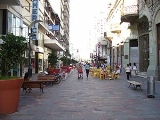
Pergamino, Buenos Aires
Encyclopedia
Pergamino is an Argentine city in the Province of Buenos Aires
. It has a population of about 104.922 inhabitants as per the and is the seat of the partido
(county) of the same name. Its UN/LOCODE
is ARPGO.
and Araucanian
people when it was first noticed by Spanish
colonist around 1620. Quickly becoming a posada
along the trade route between colonial Buenos Aires
and Córdoba
, the settlement was given its name on 3 January 1626, for the parchment paper (document lost by a group of Spaniards) found there and conforming to an Araucanian term meaning "red soil." The settlement's first businesses were established in 1700 and in 1749, recurrent attacks by displaced natives led to the construction of a fort. These attacks did not cease, however, and on 8 August 1751 the settlement was destroyed. The site continued to be of interest to the Buenos Aires government and in 1769, Commander Juan González ordered the village rebuilt. It reconstruction successful, the Curate of nearby Arrecifes ordained a Parish in Pergamino in 1779 and the new Viceroyalty of Río de la Plata assigned the area a partido (county) in 1784. The fort played a prominent role during the initial battles in the war for independence and, in 1815, was the site of a mutiny led by Col. Ignacio Álvarez Thomas
against the fledgling nation's Head of State, Director Carlos María de Alvear
. Col. Álvarez Thomas' coup d'état against Director de Alvear's brief though highly divisive autocracy averted the dissolution of the United Provinces of the Río de la Plata, the confederacy that later became Argentina.
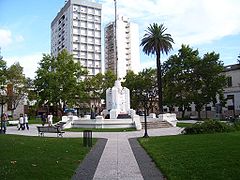
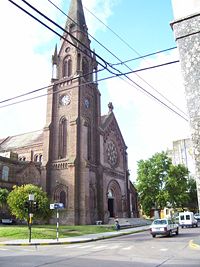 Following the struggle for independence, the progressive new Governor of Buenos Aires, Martín Rodríguez assigned Pergamino a Justice of the Peace
Following the struggle for independence, the progressive new Governor of Buenos Aires, Martín Rodríguez assigned Pergamino a Justice of the Peace
in 1822 and first school was opened in 1828. The town soon became home to a number of abattoirs and, following the 1829 advent of the regime of Governor Juan Manuel de Rosas
, whose family interests centered around cattle-raising, a close alliance developed between the governor and Pergamino's most prominent families, the Acevedos and the Anchorenas. Rosas' repressive regime resulted in the sole school's closure in 1838. Following Governor Rosas' 1852 overthrow
, the local gentry allied themselves to Bartolomé Mitre
, a prominent advocate on behalf of Buenos Aires Province for greater autonomy. Mitre was elected governor in 1860 and President of Argentina in 1862. President Mitre's 1862 establishment of Argentina's first institute of Agronomy
helped lead to the development of a new economic activity in the region around Pergamino: intensive agriculture. The first Argentine grain shipment to arrive intact in the United Kingdom
in 1875 touched off an agricultural boom that, in Pergamino, made itself evident in the massive cultivation of maïze
. The city had begun to grow, counting four schools by 1873 for instance; but the town's development only began to accelerate following the arrival of the Central Argentine Railway
in 1882, en route to Rosario. Pergamino, whose population exceeded 10,000 and home to over 90 registered businesses, was formally designated as a city on 23 October 1895.
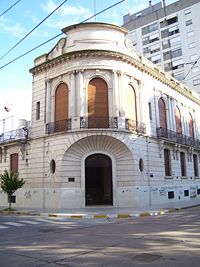 Continuing to rely economically on maize, local landowners funded the establishment of an agricultural laboratory in 1912. Pergamino's population, now mostly made of European immigrants and their children, nearly tripled to almost 30,000 between 1895 and 1914; this era saw the establishment of important Basque
Continuing to rely economically on maize, local landowners funded the establishment of an agricultural laboratory in 1912. Pergamino's population, now mostly made of European immigrants and their children, nearly tripled to almost 30,000 between 1895 and 1914; this era saw the establishment of important Basque
, Piemontese
, Provençal
and Lebanese
communities, as well as the inauguration of the Hotel Roma in 1913, one of the best-known art nouveau
structures in the area. One immigrant from the Piedmont
, Enrique Venini, founded Pergamino's first newspaper, La Opinión, in 1917. The city's growing immigrant communities also included a sizable contingent of British railway engineers and other technicians associated with the rapidly expanding railways
. A number of these staffers and the Central Argentine Railway's director, Ronald Leslie, organized Pergamino's first football team on 18 November 1918, christening it in honor of a British Field Marshal famed for his roles in the Boer War
and in World War I
, Gen. Douglas Haig
. Club Atlético Douglas Haig
has enjoyed regional prominence, long forming part of the Argentine B League
.
Pergamino's main church and city hall were both completed in 1930. Following a decade of prosperity, the great depression
led to the ruin of the majority of the area's small landholders; the city soon began to recover, however, and celebrated the opening of the Municipal Fine Arts Museum in 1936, for instance. A devastating flood in 1939 led to construction of levees and canals along the Pergamino River. Growing to nearly 50,000 people by 1947, the city's first large manufacturing establishments began to operate. Pergamino's agricultural sector, however, was strained by the creation of a national export grain purchaser, the IAPI, by Pres. Juan Perón
in 1946; although Pergamino benefited from IAPI investment in irrigation and other infrastructure works, the low prices the agency paid local growers also led to the bankruptcy of number. The dissolution of the IAPI following Perón's overthrow in 1955 and the 1956 establishment of the National Agricultural Laboratory
(INTA) in Pergamino helped revitalize the sector in the area and nationally.
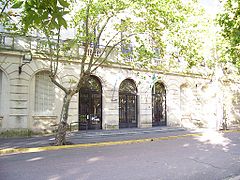
.jpg) The elections of 1963
The elections of 1963
carried a native of Pergamino, Dr. Arturo Illia, to the Presidency; President Illia prioritized economic growth while keeping national budgets nearly balanced, the combination of which led to unprecedented growth in Pergamino. The city's first high-rises were built, as well as the industrial district. Pres. Illia graced his birthplace with numerous visits during his tenure. Another native of Pergamino, Héctor Chavero, became nationally renowned during that era after releasing an album of folklore ballads and narration, El payador perseguido ("The Persecuted Troubadour"); by then, he was known by his pseudonym, Atahualpa Yupanqui
and has remained, long after his passing in 1992, arguably the most influential musician of his genre in Argentina.
One of Pergamino's Lebanese immigrants, Isaac Annan, had established the city's first garment factory during the late 1940s, creating Far West Jeans and Manhattan Shirts, two of Argentina's best-known domestic clothing brands; by 1970, Wrangler Jeans
, Fiorucci
, Levi's, Lee Jeans and a number of local firms has established several large textile plants, employing about 6,000. A son of French
immigrants, Roberto Genoud, established the area's largest lumber and furniture factory. Pergamino had, by then, become northern Buenos Aires Province's industrial center. Economic instability nationwide began to take its toll on that sector after 1975, however; by 1985, a number of local textile manufacturers had closed and been replaced by smaller cooperative
s. Pergamino continued to grow, reaching a population of 70,000 in 1980. It was chosen as the site for the prestigious National Viral Research Institute
(INEVH) in 1978, and was home to one of the nation's first cable television
stations in 1985. National economic problems saddled the city, however, leading to increased unemployment and the temporary closure of La Opinión in 1989, for instance. Financially distressed, the daily's founders, the Veninis, sold the company to local cable TV entrepenueur Hugo Apesteguía, the current owner.
Serious floods in 1975, 1984 and 1995 underscored the need for more investments in infrastructure and by 2002, the combined effects of a wave of imports and an acute economic crisis led to the closure of most of Pergamino's industries and many of its retail establishments; the textile industry, in particular, was reduced to about 600 workers; amid rising crime rates and general pessimism, one of the most notable achievements in that difficult era was the establishment of the Pergamino Regional University, the city's first institution of higher learning, in 1993. The school was absorbed into the National University of Northwestern Buenos Aires
upon that latter entity's creation in 2002, and its Pergamino campus today enrolls about 500 students yearly.
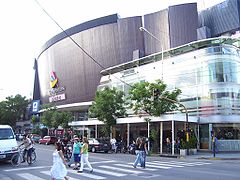 The economic recovery Argentina began to experience in 2003 has led to a dramatic recovery in the city's industrial base, as well the area's agricultural production; in 2003 alone, the city saw 2,500 manufacturing jobs return. The county's 2950 km² (1,139 sq mi) is dedicated almost entirely to agriculture
The economic recovery Argentina began to experience in 2003 has led to a dramatic recovery in the city's industrial base, as well the area's agricultural production; in 2003 alone, the city saw 2,500 manufacturing jobs return. The county's 2950 km² (1,139 sq mi) is dedicated almost entirely to agriculture
and, though local farmers have diversified into poultry and dairy production, Pergamino still plays an important role in Argentina's cereal harvest, particularly soy and maize, as well as being home to half the national sales of seed for cultivation; as such, the city was declared National Capital of the Seed in 1998. Even so, agricultural employment accounts for only 8% of the county's total and employment in manufacturing, which has growing by about 13% annually, accounted for 22% of the total in 2006, or about 10,000 jobs. Though still led by the textile and lumber industries, manufacturing in Pergamino is more diversified than in the past and these two sectors today employ less than a third of industrial labor. Pergamino's financial sector has likewise recovered: the value of locally originated loans nearly doubled between 2002 and 2006, reaching US$52 million and local deposits nearly tripled, reaching almost US$100 million.
The mayor of Pergamino, Dr. Héctor Gutiérrez, is (as most of the city's past mayors) affiliated with the centrist Radical Civic Union
, Argentina's oldest continuously existing political party. Elected in 1999, he has capitalized on the city's economic recovery by emphasizing public works and in 2005, successfully lobbied the Administration of President Néstor Kirchner
for a 180 km (112 mi) extension of the Route 8 expressway into Pergamino, a long-overdue improvement for one of the nation's most-transited stretches of two-lane road.
Former President of Argentina from October 12, 1963, to June 28, 1966, and a member of the centrist UCR.
Atahualpa Yupanqui
(22 January 1908 - 23 May 1992) was an Argentine singer, songwriter, guitarist, and writer. He is considered the most important Argentine folk musician of the 20th century. http://www.wordiq.com/definition/Atahualpa_Yupanqui Atahualpa Yupanki: Héctor Roberto Chavero
José Luis “Pepe” Motta http://www.lmsrecords.com/lmsrecords_cd.php?cdid=26 Pepe Motta Quartet He began his career playing tangos at the age of 14 years in Argentina. He won including two Emmy Awards, the music of the "Rose Parade" special live event for the Univision television network in the United States in 2000 and 2001. As a composer, arranger and producer received several awards, such as platinum and gold, for two consecutive years. He was on the list of "most famous Latino Producers" at Billboard magazine, the Univision television network named him "Best Producer of the Year " and also received the award from BMI's most popular song. http://www.pepemotta.com/ Pepe Motta
Paola Suárez
(born 23 June 1976 in Pergamino, Buenos Aires, Argentina) was a top 10 tennis player in the early 2000s.
Augusto Fernández
(Football Player) for the famous River Plate
and Vélez Sársfield
Teams.
Carlos Barbarito
(Poet)
Buenos Aires Province
The Province of Buenos Aires is the largest and most populous province of Argentina. It takes the name from the city of Buenos Aires, which used to be the provincial capital until it was federalized in 1880...
. It has a population of about 104.922 inhabitants as per the and is the seat of the partido
Partido
A partido is an administrative subdivision of the . They are formally considered to be a single municipality, and usually contain one or more population centers...
(county) of the same name. Its UN/LOCODE
UN/LOCODE
UN/LOCODE, the United Nations Code for Trade and Transport Locations, is a geographic coding scheme developed and maintained by United Nations Economic Commission for Europe , a unit of the United Nations. UN/LOCODE assigns codes to locations used in trade and transport with functions such as...
is ARPGO.
History
Long valued for its many springs and fertile land, the area had been home to the CharrúaCharrua
The Charrúa were an indigenous people of southern South America in the area today known as Uruguay and southern Brazil. They were a nomadic people that sustained themselves through fishing and foraging...
and Araucanian
Mapuche
The Mapuche are a group of indigenous inhabitants of south-central Chile and southwestern Argentina. They constitute a wide-ranging ethnicity composed of various groups who shared a common social, religious and economic structure, as well as a common linguistic heritage. Their influence extended...
people when it was first noticed by Spanish
Spain
Spain , officially the Kingdom of Spain languages]] under the European Charter for Regional or Minority Languages. In each of these, Spain's official name is as follows:;;;;;;), is a country and member state of the European Union located in southwestern Europe on the Iberian Peninsula...
colonist around 1620. Quickly becoming a posada
Posada
Posada , also previously known as Feronia or Pausata, is a comune in the Province of Nuoro in the Italian region Sardinia. The city sits on the coast of the Tyrrhenian Sea...
along the trade route between colonial Buenos Aires
Buenos Aires
Buenos Aires is the capital and largest city of Argentina, and the second-largest metropolitan area in South America, after São Paulo. It is located on the western shore of the estuary of the Río de la Plata, on the southeastern coast of the South American continent...
and Córdoba
Córdoba, Argentina
Córdoba is a city located near the geographical center of Argentina, in the foothills of the Sierras Chicas on the Suquía River, about northwest of Buenos Aires. It is the capital of Córdoba Province. Córdoba is the second-largest city in Argentina after the federal capital Buenos Aires, with...
, the settlement was given its name on 3 January 1626, for the parchment paper (document lost by a group of Spaniards) found there and conforming to an Araucanian term meaning "red soil." The settlement's first businesses were established in 1700 and in 1749, recurrent attacks by displaced natives led to the construction of a fort. These attacks did not cease, however, and on 8 August 1751 the settlement was destroyed. The site continued to be of interest to the Buenos Aires government and in 1769, Commander Juan González ordered the village rebuilt. It reconstruction successful, the Curate of nearby Arrecifes ordained a Parish in Pergamino in 1779 and the new Viceroyalty of Río de la Plata assigned the area a partido (county) in 1784. The fort played a prominent role during the initial battles in the war for independence and, in 1815, was the site of a mutiny led by Col. Ignacio Álvarez Thomas
Ignacio Álvarez Thomas
José Ignacio Álvarez Thomas was a South American military commander and politician of the early 19th century....
against the fledgling nation's Head of State, Director Carlos María de Alvear
Carlos María de Alvear
Carlos María de Alvear was an Argentine soldier and statesman, Supreme Director of the United Provinces of the Río de la Plata in 1815....
. Col. Álvarez Thomas' coup d'état against Director de Alvear's brief though highly divisive autocracy averted the dissolution of the United Provinces of the Río de la Plata, the confederacy that later became Argentina.


Justice of the Peace
A justice of the peace is a puisne judicial officer elected or appointed by means of a commission to keep the peace. Depending on the jurisdiction, they might dispense summary justice or merely deal with local administrative applications in common law jurisdictions...
in 1822 and first school was opened in 1828. The town soon became home to a number of abattoirs and, following the 1829 advent of the regime of Governor Juan Manuel de Rosas
Juan Manuel de Rosas
Juan Manuel de Rosas , was an argentine militar and politician, who was elected governor of the province of Buenos Aires in 1829 to 1835, and then of the Argentine Confederation from 1835 until 1852...
, whose family interests centered around cattle-raising, a close alliance developed between the governor and Pergamino's most prominent families, the Acevedos and the Anchorenas. Rosas' repressive regime resulted in the sole school's closure in 1838. Following Governor Rosas' 1852 overthrow
Battle of Caseros
The Battle of Caseros was fought near the town of Caseros, more precisely between the present-day train stations of Caseros and Palomar in Buenos Aires Province, Argentina, on 3 February 1852, between the Army of Buenos Aires commanded by Juan Manuel de Rosas...
, the local gentry allied themselves to Bartolomé Mitre
Bartolomé Mitre
Bartolomé Mitre Martínez was an Argentine statesman, military figure, and author. He was the President of Argentina from 1862 to 1868.-Life and times:...
, a prominent advocate on behalf of Buenos Aires Province for greater autonomy. Mitre was elected governor in 1860 and President of Argentina in 1862. President Mitre's 1862 establishment of Argentina's first institute of Agronomy
Agronomy
Agronomy is the science and technology of producing and using plants for food, fuel, feed, fiber, and reclamation. Agronomy encompasses work in the areas of plant genetics, plant physiology, meteorology, and soil science. Agronomy is the application of a combination of sciences like biology,...
helped lead to the development of a new economic activity in the region around Pergamino: intensive agriculture. The first Argentine grain shipment to arrive intact in the United Kingdom
United Kingdom
The United Kingdom of Great Britain and Northern IrelandIn the United Kingdom and Dependencies, other languages have been officially recognised as legitimate autochthonous languages under the European Charter for Regional or Minority Languages...
in 1875 touched off an agricultural boom that, in Pergamino, made itself evident in the massive cultivation of maïze
Maize
Maize known in many English-speaking countries as corn or mielie/mealie, is a grain domesticated by indigenous peoples in Mesoamerica in prehistoric times. The leafy stalk produces ears which contain seeds called kernels. Though technically a grain, maize kernels are used in cooking as a vegetable...
. The city had begun to grow, counting four schools by 1873 for instance; but the town's development only began to accelerate following the arrival of the Central Argentine Railway
Central Argentine Railway
The Central Argentine Railway was one of the Big Four broad gauge, , British-owned companies that built and operated railway networks in Argentina...
in 1882, en route to Rosario. Pergamino, whose population exceeded 10,000 and home to over 90 registered businesses, was formally designated as a city on 23 October 1895.

Basque people
The Basques as an ethnic group, primarily inhabit an area traditionally known as the Basque Country , a region that is located around the western end of the Pyrenees on the coast of the Bay of Biscay and straddles parts of north-central Spain and south-western France.The Basques are known in the...
, Piemontese
Piedmont
Piedmont is one of the 20 regions of Italy. It has an area of 25,402 square kilometres and a population of about 4.4 million. The capital of Piedmont is Turin. The main local language is Piedmontese. Occitan is also spoken by a minority in the Occitan Valleys situated in the Provinces of...
, Provençal
Provence
Provence ; Provençal: Provença in classical norm or Prouvènço in Mistralian norm) is a region of south eastern France on the Mediterranean adjacent to Italy. It is part of the administrative région of Provence-Alpes-Côte d'Azur...
and Lebanese
Lebanon
Lebanon , officially the Republic of LebanonRepublic of Lebanon is the most common term used by Lebanese government agencies. The term Lebanese Republic, a literal translation of the official Arabic and French names that is not used in today's world. Arabic is the most common language spoken among...
communities, as well as the inauguration of the Hotel Roma in 1913, one of the best-known art nouveau
Art Nouveau
Art Nouveau is an international philosophy and style of art, architecture and applied art—especially the decorative arts—that were most popular during 1890–1910. The name "Art Nouveau" is French for "new art"...
structures in the area. One immigrant from the Piedmont
Piedmont
Piedmont is one of the 20 regions of Italy. It has an area of 25,402 square kilometres and a population of about 4.4 million. The capital of Piedmont is Turin. The main local language is Piedmontese. Occitan is also spoken by a minority in the Occitan Valleys situated in the Provinces of...
, Enrique Venini, founded Pergamino's first newspaper, La Opinión, in 1917. The city's growing immigrant communities also included a sizable contingent of British railway engineers and other technicians associated with the rapidly expanding railways
Rail transport in Argentina
The Argentine railway network comprised of track at the end of the Second World War and was, in its time, one of the most extensive and prosperous in South America. However, with the increase in highway construction, there followed a sharp decline in railway profitability, leading to the break-up...
. A number of these staffers and the Central Argentine Railway's director, Ronald Leslie, organized Pergamino's first football team on 18 November 1918, christening it in honor of a British Field Marshal famed for his roles in the Boer War
Boer War
The Boer Wars were two wars fought between the British Empire and the two independent Boer republics, the Oranje Vrijstaat and the Republiek van Transvaal ....
and in World War I
World War I
World War I , which was predominantly called the World War or the Great War from its occurrence until 1939, and the First World War or World War I thereafter, was a major war centred in Europe that began on 28 July 1914 and lasted until 11 November 1918...
, Gen. Douglas Haig
Douglas Haig
Douglas Haig, 1st Earl Haig was a British soldier and senior commander during World War I.Douglas Haig may also refer to:* Club Atlético Douglas Haig, a football club from Argentina* Douglas Haig , American actor...
. Club Atlético Douglas Haig
Club Atlético Douglas Haig
Club Atlético Douglas Haig is a football club from Pergamino in Buenos Aires Province, Argentina. They currently play in Zone 1 of the Torneo Argentino A, which is the regionalised third tier of the Argentine Football Association league system....
has enjoyed regional prominence, long forming part of the Argentine B League
Torneo Argentino B
Torneo Argentino B is one of two leagues that form the regionalised fourth level of the Argentine football league system. Clubs in Torneo Argentinos B come from all over Argentina....
.
Pergamino's main church and city hall were both completed in 1930. Following a decade of prosperity, the great depression
Great Depression
The Great Depression was a severe worldwide economic depression in the decade preceding World War II. The timing of the Great Depression varied across nations, but in most countries it started in about 1929 and lasted until the late 1930s or early 1940s...
led to the ruin of the majority of the area's small landholders; the city soon began to recover, however, and celebrated the opening of the Municipal Fine Arts Museum in 1936, for instance. A devastating flood in 1939 led to construction of levees and canals along the Pergamino River. Growing to nearly 50,000 people by 1947, the city's first large manufacturing establishments began to operate. Pergamino's agricultural sector, however, was strained by the creation of a national export grain purchaser, the IAPI, by Pres. Juan Perón
Juan Perón
Juan Domingo Perón was an Argentine military officer, and politician. Perón was three times elected as President of Argentina though he only managed to serve one full term, after serving in several government positions, including the Secretary of Labor and the Vice Presidency...
in 1946; although Pergamino benefited from IAPI investment in irrigation and other infrastructure works, the low prices the agency paid local growers also led to the bankruptcy of number. The dissolution of the IAPI following Perón's overthrow in 1955 and the 1956 establishment of the National Agricultural Laboratory
Instituto Nacional de Tecnología Agropecuaria
The National Agricultural Technology Institute , commonly known as INTA, is an Argentine federal agency in charge of the generation, adaptation and diffusion of technologies, knowledge and learning procedures for the agriculture, forest and agro-industrial activities within an ecologically clean...
(INTA) in Pergamino helped revitalize the sector in the area and nationally.

.jpg)
Argentine general election, 1963
The Argentine general election of 1963 was held on 7 July. Voters chose both the President and their legislators and with a turnout of 85.6%, it produced the following results:-President:aAbstentions.-Argentine Chamber of Deputies:...
carried a native of Pergamino, Dr. Arturo Illia, to the Presidency; President Illia prioritized economic growth while keeping national budgets nearly balanced, the combination of which led to unprecedented growth in Pergamino. The city's first high-rises were built, as well as the industrial district. Pres. Illia graced his birthplace with numerous visits during his tenure. Another native of Pergamino, Héctor Chavero, became nationally renowned during that era after releasing an album of folklore ballads and narration, El payador perseguido ("The Persecuted Troubadour"); by then, he was known by his pseudonym, Atahualpa Yupanqui
Atahualpa Yupanqui
Atahualpa Yupanqui was an Argentine singer, songwriter, guitarist, and writer. He is considered the most important Argentine folk musician of the 20th century....
and has remained, long after his passing in 1992, arguably the most influential musician of his genre in Argentina.
One of Pergamino's Lebanese immigrants, Isaac Annan, had established the city's first garment factory during the late 1940s, creating Far West Jeans and Manhattan Shirts, two of Argentina's best-known domestic clothing brands; by 1970, Wrangler Jeans
Wrangler Jeans
Wrangler is a manufacturer of jeans and other clothing items. The brand is owned by the VF Corporation, who also own Lee, JanSport and The North Face, among others. Its headquarters is in downtown Greensboro, North Carolina, with production plants in a variety of locations throughout the world...
, Fiorucci
Fiorucci
Fiorucci is an Italian fashion label founded by Elio Fiorucci in 1967. The first shop exposed Milan to the styles of Swinging London and American classics such as the T-shirt and jeans. By the late 1970s and early 1980s this would be reversed, and the New York store would become famous for the...
, Levi's, Lee Jeans and a number of local firms has established several large textile plants, employing about 6,000. A son of French
France
The French Republic , The French Republic , The French Republic , (commonly known as France , is a unitary semi-presidential republic in Western Europe with several overseas territories and islands located on other continents and in the Indian, Pacific, and Atlantic oceans. Metropolitan France...
immigrants, Roberto Genoud, established the area's largest lumber and furniture factory. Pergamino had, by then, become northern Buenos Aires Province's industrial center. Economic instability nationwide began to take its toll on that sector after 1975, however; by 1985, a number of local textile manufacturers had closed and been replaced by smaller cooperative
Cooperative
A cooperative is a business organization owned and operated by a group of individuals for their mutual benefit...
s. Pergamino continued to grow, reaching a population of 70,000 in 1980. It was chosen as the site for the prestigious National Viral Research Institute
Maiztegui National Human Viral Disease Institute
The Maiztegui National Human Viral Disease Institute is a viral research laboratory in Pergamino, Argentina.-Overview:The INEVH originated in the Clinical Research and Medical Education Center in Pergamino...
(INEVH) in 1978, and was home to one of the nation's first cable television
Cable television
Cable television is a system of providing television programs to consumers via radio frequency signals transmitted to televisions through coaxial cables or digital light pulses through fixed optical fibers located on the subscriber's property, much like the over-the-air method used in traditional...
stations in 1985. National economic problems saddled the city, however, leading to increased unemployment and the temporary closure of La Opinión in 1989, for instance. Financially distressed, the daily's founders, the Veninis, sold the company to local cable TV entrepenueur Hugo Apesteguía, the current owner.
Serious floods in 1975, 1984 and 1995 underscored the need for more investments in infrastructure and by 2002, the combined effects of a wave of imports and an acute economic crisis led to the closure of most of Pergamino's industries and many of its retail establishments; the textile industry, in particular, was reduced to about 600 workers; amid rising crime rates and general pessimism, one of the most notable achievements in that difficult era was the establishment of the Pergamino Regional University, the city's first institution of higher learning, in 1993. The school was absorbed into the National University of Northwestern Buenos Aires
National University of Northwestern Buenos Aires
The National University of Northwestern Buenos Aires is a national university with head office and campus in Junín, Argentina, which hosts around 60% of students...
upon that latter entity's creation in 2002, and its Pergamino campus today enrolls about 500 students yearly.
The city today

Agriculture
Agriculture is the cultivation of animals, plants, fungi and other life forms for food, fiber, and other products used to sustain life. Agriculture was the key implement in the rise of sedentary human civilization, whereby farming of domesticated species created food surpluses that nurtured the...
and, though local farmers have diversified into poultry and dairy production, Pergamino still plays an important role in Argentina's cereal harvest, particularly soy and maize, as well as being home to half the national sales of seed for cultivation; as such, the city was declared National Capital of the Seed in 1998. Even so, agricultural employment accounts for only 8% of the county's total and employment in manufacturing, which has growing by about 13% annually, accounted for 22% of the total in 2006, or about 10,000 jobs. Though still led by the textile and lumber industries, manufacturing in Pergamino is more diversified than in the past and these two sectors today employ less than a third of industrial labor. Pergamino's financial sector has likewise recovered: the value of locally originated loans nearly doubled between 2002 and 2006, reaching US$52 million and local deposits nearly tripled, reaching almost US$100 million.
The mayor of Pergamino, Dr. Héctor Gutiérrez, is (as most of the city's past mayors) affiliated with the centrist Radical Civic Union
Radical Civic Union
The Radical Civic Union is a political party in Argentina. The party's positions on issues range from liberal to social democratic. The UCR is a member of the Socialist International. Founded in 1891 by radical liberals, it is the oldest political party active in Argentina...
, Argentina's oldest continuously existing political party. Elected in 1999, he has capitalized on the city's economic recovery by emphasizing public works and in 2005, successfully lobbied the Administration of President Néstor Kirchner
Néstor Kirchner
Néstor Carlos Kirchner was an Argentine politician who served as the 54th President of Argentina from 25 May 2003 until 10 December 2007. Previously, he was Governor of Santa Cruz Province since 10 December 1991. He briefly served as Secretary General of the Union of South American Nations ...
for a 180 km (112 mi) extension of the Route 8 expressway into Pergamino, a long-overdue improvement for one of the nation's most-transited stretches of two-lane road.
Some Known People from Pergamino
Arturo Umberto IlliaArturo Umberto Illia
Arturo Umberto Illia was President of Argentina from October 12, 1963, to June 28, 1966, and a member of the centrist UCR.-Biography:Arturo Umberto Illia was born August 4, 1900 in Pergamino, Buenos Aires Province, to Emma Francesconi and Martín Illia, Italian Argentine immigrants from the...
Former President of Argentina from October 12, 1963, to June 28, 1966, and a member of the centrist UCR.
Atahualpa Yupanqui
Atahualpa Yupanqui
Atahualpa Yupanqui was an Argentine singer, songwriter, guitarist, and writer. He is considered the most important Argentine folk musician of the 20th century....
(22 January 1908 - 23 May 1992) was an Argentine singer, songwriter, guitarist, and writer. He is considered the most important Argentine folk musician of the 20th century. http://www.wordiq.com/definition/Atahualpa_Yupanqui Atahualpa Yupanki: Héctor Roberto Chavero
José Luis “Pepe” Motta http://www.lmsrecords.com/lmsrecords_cd.php?cdid=26 Pepe Motta Quartet He began his career playing tangos at the age of 14 years in Argentina. He won including two Emmy Awards, the music of the "Rose Parade" special live event for the Univision television network in the United States in 2000 and 2001. As a composer, arranger and producer received several awards, such as platinum and gold, for two consecutive years. He was on the list of "most famous Latino Producers" at Billboard magazine, the Univision television network named him "Best Producer of the Year " and also received the award from BMI's most popular song. http://www.pepemotta.com/ Pepe Motta
Paola Suárez
Paola Suárez
Paola Suárez was a top 10 tennis player in the early 2000s. She gained prominence in 2004 by reaching the finals of nine straight WTA doubles tournaments, and by reaching the singles semifinals of the French Open tournament, held in Paris."La Negra" Suárez began playing professional tennis at the...
(born 23 June 1976 in Pergamino, Buenos Aires, Argentina) was a top 10 tennis player in the early 2000s.
Augusto Fernández
Augusto Fernández
Augusto Matías Fernández is an Argentine football right winger playing for Vélez Sársfield in the Argentine Primera División.- Career :...
(Football Player) for the famous River Plate
Club Atlético River Plate
Club Atlético River Plate is an Argentine sports club based in the Nuñez neighborhood of Buenos Aires. It is best known for its professional football team, which currently competes in Nacional B, the second tier of Argentine football....
and Vélez Sársfield
Club Atlético Vélez Sársfield
Club Atlético Vélez Sársfield is a sports club based in the Liniers neighborhood of western Buenos Aires, Argentina. Vélez is best known for its football team, that plays in the Argentine Primera División, the top level of the Argentine league system...
Teams.
Carlos Barbarito
Carlos Barbarito
Carlos Barbarito is an Argentine poet born in Pergamino, Buenos Aires, Argentina on 6 February 1955.-Books:Barnarito has wrote several books, such as:*Poesía quebrada *Teatro de lirios *Éxodos y trenes *Páginas del poeta flaco...
(Poet)

